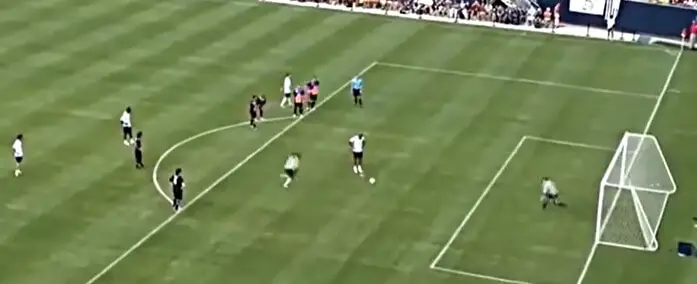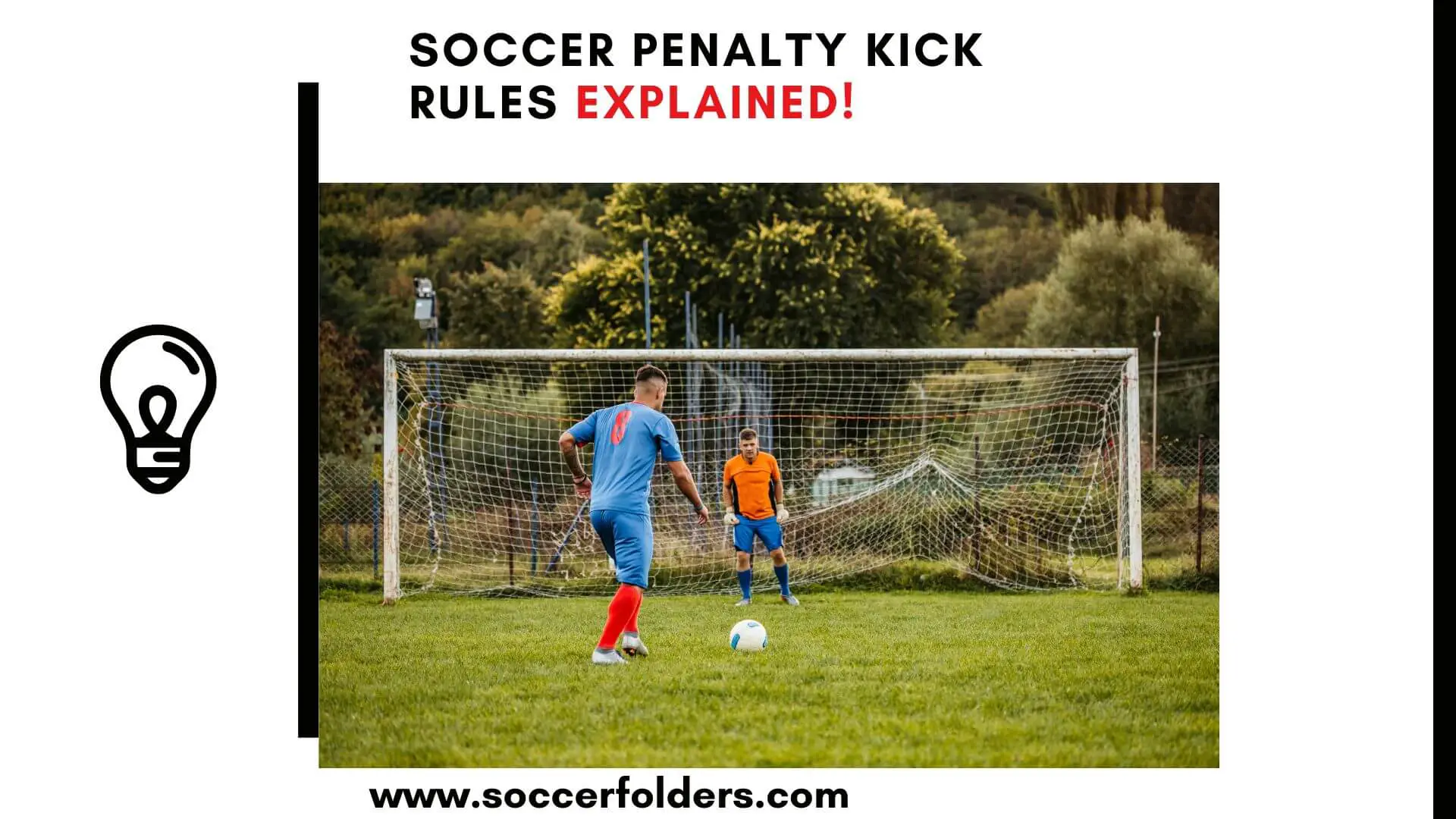So, you want to know about the rules for soccer penalty kicks, right? Well, you’re in the right place.
It’s all about that exciting moment when the ball sits on the penalty spot, the goalkeeper prepares for action, and the crowd holds its breath.
In this in-depth guide, we will break down everything you need to know about soccer’s dreaded penalty kick, from the rules that govern it to tips for taking the perfect shot.
Let’s jump right in.
Quick Navigation
- When Is a Penalty Kick Awarded?
-
Soccer Penalty Kick Rules
-
Detailed Explanations of the Rules Above
- Only 2 Players in the Penalty Area
- The Goalie Must remain on the Goal Line
- No Feinting Before Shooting the Ball
- After a penalty kick, the kicker can't touch the ball until another player does
- Extra Time is Added in a Penalty in the 90th Minute
- Goalkeeper violation during kick = Retake only if no initial goal.
- The Penalty Taker can pass the ball to a teammate to trick the goalie
-
Detailed Explanations of the Rules Above
- Penalty Kick Strategy and Technique
- Final Thoughts
When Is a Penalty Kick Awarded?
A penalty kick is awarded when a player commits a direct free kick offense inside their own penalty area. This includes fouls such as:
- Tripping, pushing, or holding an opponent
- Handling the ball (other than by the goalkeeper within their own area)
- Charging an opponent in a dangerous or reckless manner
Essentially, if the referee decides that a player has illegally obstructed an attacking player from a clear goal-scoring opportunity, play will be stopped and a penalty kick will be given.
Soccer Penalty Kick Rules
FIFA’s Laws of the Game outline several key regulations for penalty kicks:
- The kick must be taken from the penalty mark, which is 12 yards (11 m) out from the goal line.
- Only two players are allowed in the penalty area during the kick: the kicker and the goalkeeper of the defending team. All other players must stand outside the area, behind the ball.
- The goalkeeper must stay on the goal line until the ball is kicked, and cannot move their feet.
- Once the kicker starts their run-up, they must kick the ball forward. Feinting to shoot and then passing to a teammate is not allowed.
- The kicker cannot play the ball again until another player has touched it.
- If a penalty kick is awarded when regular time has expired, additional time is added for the kick to be taken.
- If the penalty taker improperly executes the kick, it must be retaken. If the goalkeeper infringes the rules, the kick is retaken only if a goal was not scored.
- The penalty taker is allowed to pass the ball to a teammate to trick the goalie
Detailed Explanations of the Rules Above
With the kicker going one-on-one against the goalkeeper, penalties provide a chance to score from just 12 yards out. Executed properly, penalties have around a 75% chance of being scored.
Only 2 Players in the Penalty Area
Only two players are permitted within the penalty area during the kick – the kicker and the defending team’s goalkeeper.
All other players from both teams must remain outside the penalty area, behind the ball, until the ball is in play.
Typically the taker’s teammates will stand just outside the area while defenders will line up along the edge of the box. This rule creates an isolated one-on-one scenario and prevents interfering with the kicker or goalkeeper.
The Goalie Must remain on the Goal Line

Secondly, the goalkeeper must remain on the goal line, facing the kicker, until the ball is kicked.
The goalkeeper is not allowed to advance off the line before the kick is taken. This prevents the goalkeeper from gaining an unfair advantage by reducing the distance to the ball.
They are, however, permitted to move side-to-side along the goal line before the kick is taken.
No Feinting Before Shooting the Ball
Once the kicker starts their run-up to kick the ball, they must complete the kick.
Feinting to shoot and then passing to a teammate instead is not permitted – the kicker must make a valid attempt to score from the kick.
This prevents tricks from being used to deceive the goalkeeper, ensuring a proper penalty is taken.
After a penalty kick, the kicker can’t touch the ball until another player does
If a goal is not scored from the penalty kick, the kicker cannot play the ball again until it has been touched by another player.
This prevents the kicker from getting an immediate second chance to score if they miss or have their shot saved.
The ball is considered live after the kick, so the kicker’s teammates can attempt to score from a rebound.
Extra Time is Added in a Penalty in the 90th Minute
If a penalty kick is awarded when the normal 90 minutes of regular time has expired, additional time is added for the penalty kick to be taken.
So a match cannot end with a penalty still to be taken – the kick must be completed to determine the final scoreline.
This ensures the penalty kick has an opportunity to impact the result as it would during regular time.
Goalkeeper violation during kick = Retake only if no initial goal.
If the kicker violates the protocols for taking the penalty, requiring a retake, the initial kick is nullified.
A kick must only be retaken after a violation by the goalkeeper if no goal was scored from the initial kick.
So if the goalkeeper infringes but the kick still goes in, the goal stands and there is no retake. This maintains the balance between fairness and not overly penalizing infringements that do not impact the outcome.
The Penalty Taker can pass the ball to a teammate to trick the goalie

You know when a player gets a penalty kick in soccer, they usually shoot the ball straight into the goal? But guess what, there’s a cool trick they can do sometimes.
Instead of shooting, they can pass the ball to a teammate, and that teammate can try to score. It’s like a surprise move that can confuse the other team’s goalkeeper.
Here’s an example: One time, Messi had a penalty kick during his time in Barcelona. Instead of taking the shot himself, he passed the ball to his buddy Suarez, who kicked it into the goal.
It was unexpected and caught everyone off guard. So, just remember, penalty takers can be sneaky and share the fun with their teammates!
You can read more about this penalty through One Football.
In summary, these key rules for taking a penalty ensure a fair contest between kicker and goalkeeper to decide the fate of the kick.
Adhering to the 12-yard distance, restrictions on other players, goalkeeper positioning, no feinting, no second chances for the kicker, allowance for time to complete the kick, and retakes under certain circumstances, all preserve the integrity and drama of the penalty kick.
When everything is executed properly, the penalty kick creates a pressure-filled, tactically fascinating battle.
Penalty Kick Strategy and Technique
Taking a penalty kick might seem simple on the surface, but excelling in this high-pressure scenario requires immense concentration, technique, and mental focus.
For the Kicker
When stepping up to the spot, the kicker must block out all distractions and zero in on putting the ball in the back of the net. Here are some strategies to follow:
- Pick your spot early – Experts recommend deciding where you will aim before the kick is taken to avoid telegraphing your shot at the last second. Consider targeting one of the bottom corners, which are harder for the goalkeeper to reach.
- Disguise your approach – Vary your run-up to make it harder for the goalkeeper to predict where you will aim. For example, approach the ball at an angle or slow down before striking it.
- Strike the ball with power – Unless you are aiming for placement in the top corner, hit the ball with force. Penalties struck with conviction give the goalkeeper less time to react.
- Keep it low – It’s obviously best to keep the ball low and on target. Shots at waist height are easier for keepers to save.
- Watch the goalkeeper – See which way they lean or dive before impact so you can aim in the opposite direction if needed.
For the Goalkeeper
Trying to prevent a penalty kick goal is one of soccer’s ultimate challenges. Goalies must use mind games and strategize to gain an edge.
- Do your homework – Study the kicker’s tendencies so you know which side they prefer. Top keepers keep mental notes on opponents.
- Try to distract the kicker – You may point, yell, or jump around to distract them before the kick. However, you cannot charge them before they shoot.
- Guess a side – Since reaction time is limited, pick a side and dive hard and early. Being indecisive can be costly.
- Stay big before the shot – Initially take up space by standing in the middle of the goal line to make yourself appear bigger. Only move just before impact.
- Use two saves – If you guess correctly and block the shot, be ready to make a second save on a rebound.
Final Thoughts
Penalty kicks are soccer’s ultimate test of skill and poise under pressure.
Though they may seem straightforward, excellent technique and mental preparation are required to master soccer’s most nerve-wracking moment.
With the soccer penalty kick rules and strategies above, you’ll be ready to either bury your next penalty or stop the opponent’s shot in its tracks!
You might also enjoy those articles:

